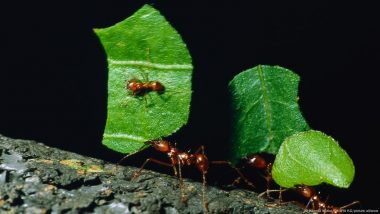Ants are complex and fascinating creatures that have been around since the dinosaurs. But because of their tiny size, it's easy to overlook the enormous role they play in nature.Ants are found all over the world, on every continent except Antarctica.
Scientists estimate that there are around 20 quadrillion of them currently scuttling around on Earth. That's 2.5 million ants for every human. If you were to put all these ants on a scale, they would weigh more than the world's wild birds and mammals combined.
Also Read | World News | Dalai Lama’s Representative Highlights Tibetan Issue in Philippines.
That's a lot of ants. And although tiny, they can have a major influence on the environments they live in.
"Ants have fascinated people for a long time," says Jack Longino, a professor of biology at the University of Utah. "They're as diverse and crazy as mammals of the Serengeti, these wild and crazy looking things."
Ants can wage wars, tend their own gardens, and keep livestock. But that's just the start. Here are some other fascinating facts you might not know about these tiny critters.
Ants have superpowers
The ant world is incredibly diverse. There are more than 15,000 known species on the planet, and they've all evolved different skills in their respective habitats.
Ants can live in soil, in trees, below ground, in leaf matter, in deserts — and in cities.
The little insects are crucial for healthy ecosystems. They churn up the soil, making it more fertile, and disperse seeds to help sustain plant systems. They can be predators, or also food for other insects and birds.
"Ants are nature's engineers, they're gardeners," says Tanya Latty, an entomologist at the University of Sydney in Australia. "Ants do so many different jobs in the ecosystem that it would be terrible without them."
They have also evolved some pretty cool abilities, almost like superpowers. Take the incredibly speedy Saharan Silver Ant. It can move 100 body lengths per second, which is like a human being able to run 200 meters per second. And its not just speed — they are also super strong: some ants can even carry 50 times their own body weight.
How does the ant colony function?
Ants are social insects. They typically live in colonies that can range from a couple of hundred to populations in the millions. To keep all these individuals alive and fed, the colony works like a well-oiled machine.
Each ant performs specific roles for the good of the group. There might be one queen, or multiple queens, whose job is to reproduce. All the rest of the ants are female workers, who are tasked with caring for the eggs and larvae, foraging for food, excavating the nest and defending it from danger.
Male ants have short lives and only one task: to mate with the queen.
To communicate in their huge colonies, ants constantly touch each other with their front feelers, or antennae. They also use chemical signals to lead their fellow workers to a tasty meal, or to warn them of danger.
Agricultural ants herding bugs
Some ants secure their food supply by "farming." Leaf cutter ants are a famous example. These herbivores are known for walking in lines carrying small pieces of leaves over their heads, like mini umbrellas. But instead of eating those leaves back at the nest, they mush them up into compost to cultivate a fungus. And its this fungus that becomes their food. Some leaf cutter ants build huge colonies in the South American tropics, with thousands of underground fungus gardens.
Many ant species have also evolved specialized relationships with other insects, such as aphids that produce the sugar ants love to eat. The ants look after these sap-sucking bugs like cattle, essentially "milking" them for their sweet honeydew.
"That can be their main source of carbohydrates for some of these colonies. So they're super important," says Latty. In return, "they'll make sure to protect their little herds of sugar cows from predators."
What are super colonies?
Some ant species form super colonies, which can have many nests connected over a large area. The biggest known super colony belongs to the so called Argentine ant and spreads over 6,000 kilometers (3,728 miles) from northern Italy through France and southern Spain to Portugal. Originally from South America, Argentine ants now live across the world.
Many invasive ant species are capable of forming super colonies. Latty says because they can multiply quickly and produce thousands of queens, its challenging to eliminate them.
That can pose challenges, since invasive ants can damage infrastructure, attack livestock and crops, sting people and invade homes. If an invasive species takes hold, it can also displace native ants and other insects, changing the dynamics of ecosystems.
When the invasive yellow crazy ant took over Australia's Christmas Island, it killed millions of the iconic migrating red crabs by spraying them with formic acid. The island's landscape changed as a result, with vegetation sprouting up in forest areas once cleared by the crabs.
The number of ant species considered to be invasive is growing, thanks to globalization and increased trade. More than 500 species of ants have been found beyond their native range, according to scientists. Around 20 of those species are considered to be particularly invasive — meaning they have a negative impact on the environment and economy. Invasive ants caused an estimated $51 billion in economic losses between 1930 and 2021.
Climate change, habitat loss and other threats
Human behavior is driving biodiversity loss worldwide. That also affects ants, despite their big numbers.
The spread of invasive species, human-induced climate change, and habitat destruction are all potential threats to ants.
"Some (ants) have quite small colonies. Some of them have very tight relationships with particular plants. And if those interactions go awry, then we lose that species," Latty says.
Climate change could also allow invasive species to proliferate more, providing new opportunities for native ants to be displaced or wiped out altogether, says Cleo Bertelsmeier, an ant ecologist from the University of Lausanne.
"Many ant species come from the tropics, from the subtropics, from Mediterranean areas. And for those species it will be much easier to invade places in temperate Europe, like Switzerland, Germany, northern France," she says.
The conversion of habitats and rising temperatures are also causes for concern, says Jack Longino at the University of Utah. As the planet continues to heat up from the burning of fossil fuels, the prospects aren't good for ants that have adapted to higher elevations, where its colder, he says.
"They're going to get run off the top of the mountain, they won't have anywhere to go."
Edited by: Anke Rasper
Sources:
The abundance, biomass, and distribution of ants on Earth, published in PNAS
https://www.pnas.org/doi/abs/10.1073/pnas.2201550119
Economic costs of invasive alien ants worldwide, published in Biological Invasions
https://link.springer.com/article/10.1007/s10530-022-02791-w
The global spread and invasion capacities of alien ants, published in Current Biology https://www.sciencedirect.com/science/article/pii/S0960982222019200
Listen to the full episode about ants on the Living Planet podcast here.
(The above story first appeared on LatestLY on Oct 28, 2024 04:00 PM IST. For more news and updates on politics, world, sports, entertainment and lifestyle, log on to our website latestly.com).













 Quickly
Quickly




















